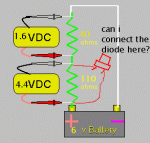hi im making a homemade violet laser and i need some help with the electronics,
i am using a 405nm diode that takes 4.4V and 40ma im going to run it off 4 AA batteries in series (6v max) i was wondering if anyone here would know what i would need to get it to 4.4v\40ma im pretty sure ill need a 150ohm resistor to get it to 40ma but im a bit confused about the voltage.
ive found a picture and modified if to see if this is possible to avoid explaining it.
i am using a 405nm diode that takes 4.4V and 40ma im going to run it off 4 AA batteries in series (6v max) i was wondering if anyone here would know what i would need to get it to 4.4v\40ma im pretty sure ill need a 150ohm resistor to get it to 40ma but im a bit confused about the voltage.
ive found a picture and modified if to see if this is possible to avoid explaining it.






